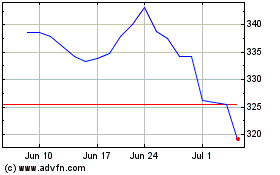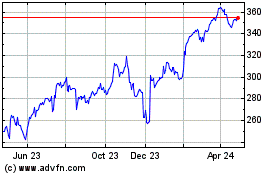By Stephanie Armour
Hospitals would have to disclose the discounted prices they
negotiate with insurance companies under a Trump administration
rule that could upend the $1 trillion hospital industry by
revealing rates long guarded as trade secrets.
Hospitals that fail to share the discounted prices in an online
form could be fined up to $300 a day, according to information on
the proposal viewed by The Wall Street Journal. The
price-disclosure requirements would cover all the more than 6,000
hospitals that accept Medicare.
Comments on the proposal would be due in September and, if
completed, the rule would take effect in January.
Hospitals would have to disclose the rates for services and
treatment that they have negotiated with individual insurance
companies such as Aetna Inc., Cigna Corp. and Anthem Inc. under the
proposal released Monday. The Trump administration is also working
on initiatives that could compel insurers to disclose their rates,
part of a push to publicize costs that is likely to spur lawsuits
and sharp resistance from the industry.
The initiative represents the Trump administration's growing
effort to shift away from rolling back the Affordable Care Act
rollback and put its own stamp on health care instead. Central to
that strategy is the notion that more price transparency will
inject greater competition into the market and lower costs.
"It's very significant. It's a turning point in health care and
a turning point to free market in health care," Seema Verma,
administrator of the Centers for Medicare and Medicaid Services,
said in an interview. "It hasn't been a competitive free-market
system."
The initiative contrasts sharply with proposals by some leading
Democratic presidential contenders who say Medicare for All will
drive down costs by lowering administrative overhead, curbing
spending and leveraging the federal government's negotiating clout
to drive down prices.
Industry groups have argued that mandatory price disclosure
could push up costs if hospitals see competitors are getting higher
payments and demand the same. They say the federal government is
overstepping its statutory authority and interfering in private
contracts between insurers and hospitals. The contracts are
generally bound by confidentiality agreements.
Tom Nickels, executive vice president of the American Hospital
Association, has said consumers care more about their expected
out-of-pocket costs.
"Disclosing negotiated rates between insurers and hospitals
could undermine the choices available in the private market," he
told the Journal in March, when the White House was considering
initiatives on price disclosure. "While we support transparency,
this approach misses the mark."
The proposed rule is estimated to cost hospitals around $6
million. It would affect hospitals as well as their subsidiaries,
including outpatient health clinics.
Hospitals must already post their list prices for services. The
administration's proposal would expand that requirement to include
gross charges before discounts as well as the insurer-specific
negotiated charges for all items and services. The charges would
have to be linked to the name of the insurer.
The data would have to be displayed in a machine-readable format
so it could be processed by a computer, and listed by common
billing or accounting codes to create a framework for comparing
standard charges among hospitals.
The proposal would also require hospitals to disclose
insurer-specific negotiated charges for about 300 services
consumers are likely to shop for before obtaining care, such as
X-rays, outpatient visits, lab tests or childbirth. That price data
would have to be made public in a prominent location online or in
written form on request.
The rule, if finalized, would reveal how widely costs vary in
the U.S. for care. A magnetic-resonance image of the lower back
costs $141 at an imaging center in Jefferson, La., but runs $47,646
at a hospital in Torrance, Calif., according to data from Clear
Health Costs, a New York company that publishes information about
health-care costs.
Prices vary so greatly in part because of the prearranged
discounts with insurers. Patients may pay the actual list charge if
they are uninsured or have high-deductible health plans, which are
becoming more common as employers move to such plans. About 40% of
large employers offer only high-deductible plans, according to a
2018 survey by the National Business Group on Health.
"I would hope this drive on transparency would unify the left
and right, " Health and Human Services Secretary Alex Azar said in
an interview. "The opponents here are the proponents of the status
quo who will attack us."
Technology companies will use the information to make it
available for consumers and patients, he said. "Just imagine having
that information out there, how powerful it will be," he said.
Employers could also consider negotiated-cost information when
selecting health plans.
The White House is also looking into ways to connect information
on the negotiated rates with data on hospital quality, allowing
consumers to compare prices as well as possible treatment
outcomes.
The proposal follows President Trump's executive order in June
that called for the release of more health-cost information for
consumers and employers, actions the White House has said could
empower patients to price-shop for care.
Industry groups have already mobilized to fight any such
requirement, which would likely change the dynamics of the health
market. They have said consumers typically aren't well-inclined to
shop for health-care services, even when they face significant
costs under high-deductible health plans.
Data on the effect of increasing price transparency in health
care shows mixed results. In some cases, consumers equate higher
cost with higher quality and can be attracted to higher-priced
treatments and services. Other studies show that only a fraction of
people who have price data actually use the information to shop
around for care. Many are already shielded from the full costs
because insurance covers the bulk of their treatments.
But proponents say obscured prices means there is no truly
functional, economically competitive health-care market.
Transparency, they say, will introduce competition that can drive
down costs, and linking it to quality data may improve
accountability.
The proposal wouldn't affect hospitals run by Veterans Affairs,
Indian Health Services and Defense Department military treatment
centers.
Write to Stephanie Armour at stephanie.armour@wsj.com
(END) Dow Jones Newswires
July 29, 2019 16:29 ET (20:29 GMT)
Copyright (c) 2019 Dow Jones & Company, Inc.
Cigna (NYSE:CI)
Historical Stock Chart
From Aug 2024 to Sep 2024

Cigna (NYSE:CI)
Historical Stock Chart
From Sep 2023 to Sep 2024
